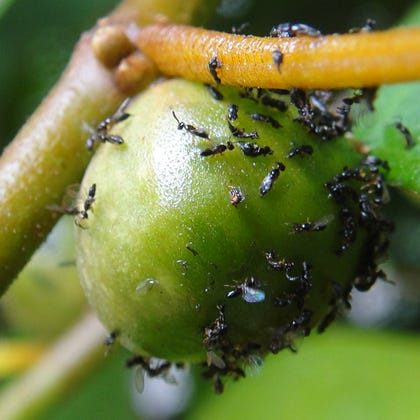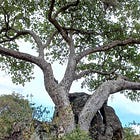How Heat Could Silence the Forest’s Heartbeat
From the wings of tiny creatures hang the fates of hundreds of bird and mammal species, and perhaps even entire rainforests.
They are fig wasps, minute insects that play a disproportionate role in the grand drama of life on Earth. They shape our own story too because of this. But research shows that they could be “extremely vulnerable” to global warming.

This matters because each of the 900+ species of fig tree (Ficus species) relies utterly on one or more particular species of fig wasp to pollinate its flowers. Without the fig wasps there would be no fig seeds to create the next generation of trees, and there would be no ripe figs for animals to eat.
In the case of any other group of trees, this might not be such a big deal. But figs are special. Their pollinator wasps live for only about a day or two, and each wasp species can lay its eggs only inside the flowers of its own fig partner.
To keep their pollinator species alive, fig species stagger their flowering so that somewhere, at any given time, there is always a fig in bloom. As a result, there are also always ripe figs with seeds ready to disperse. This means a steady supply of food for birds and mammals, and helps to explain why figs feed more species of fruit-eating animal than any other trees do.
In the late 1990s, I set out to find out just how many animal species eat figs. The answer was an astounding 1,200-plus species, including ten per cent of all birds and six per cent of all mammals. That’s the variety of life that stands to suffer in some way if fig-wasps disappear. In 2013, research by Nanthinee Jevanandam of the National University of Singapore, and colleagues, provided a chilling insight into what a warmer world could mean for these wasps.
In a laboratory, they exposed the pollinators of four Ficus species to temperatures between 25°C and 38°C and to various levels of humidity. The lifespan of all four species fell steadily as the temperature rose. By 36°C, the lifespan of three of the species had fallen to just two hours. In the wild, this would give the wasps hardly any time to find a fig of the right species in which to deliver pollen and lay its eggs. It would hurt both wasp and fig species.
This is the Achilles heel of a partnership that has endured for 80 million years. Here is where we might expect to see the relationship break down, with cascading consequences for countless other species.
This has happened before. In the 1990s, fig-wasps in northern Borneo went locally extinct after a severe drought, and in Florida they disappeared when a hurricane wiped them out. In both cases, fig-wasp populations eventually bounced back — thanks to the fact they can disperse for tens of kilometres in the day or two they live.
But a sustained rise in temperature — like the global average increase that climate scientists predict by the end of the century — is a different matter. As we turn up the planet’s thermostat, we change the chemistry of life.
I asked Nanthinee whether she thought fig-wasps could adapt to a rise in temperature, either in their physiology or their behaviour — by flying at a cooler time of day, for instance.
“Fig wasps can produce up to 12 generations in a year in the aseasonal tropics, and so acclimation or genetic adaption is a possibility,” she said. “But more research has to be carried out to ascertain this. As to the possibility flying at different times, it is difficult to predict.”
The wasp species that she and her colleagues studied came from distinct branches of the fig-wasp family tree, so they think their results will be relevant to hundreds of other fig-wasp species, the trees they pollinate and the animals that eat their figs.
In 2022, researchers working in Panama reported similar declines in fig-wasp lifespans under experimentally elevated temperatures. They warned that if fig-wasps cannot adapt to a warmer world in time, the survival of their mutualism with fig trees could eventually be at stake. This would spell disaster for so many species of fig-eating animal and the plants whose seeds they disperse.
But these little wasps might still surprise us. They survived the mass extinction that wiped out the giant dinosaurs 65 million years ago. They might even outlast us. But if they are to survive the heat we are unleashing — and if we are to survive it too — both of us will need to adapt, and fast.
Thanks for reading. I have many more astounding stories about fig trees in the pipeline. If you’ve found value in my work here, your support — whether through sharing the newsletter, commenting or becoming a paid subscriber — will help keep this project growing.






